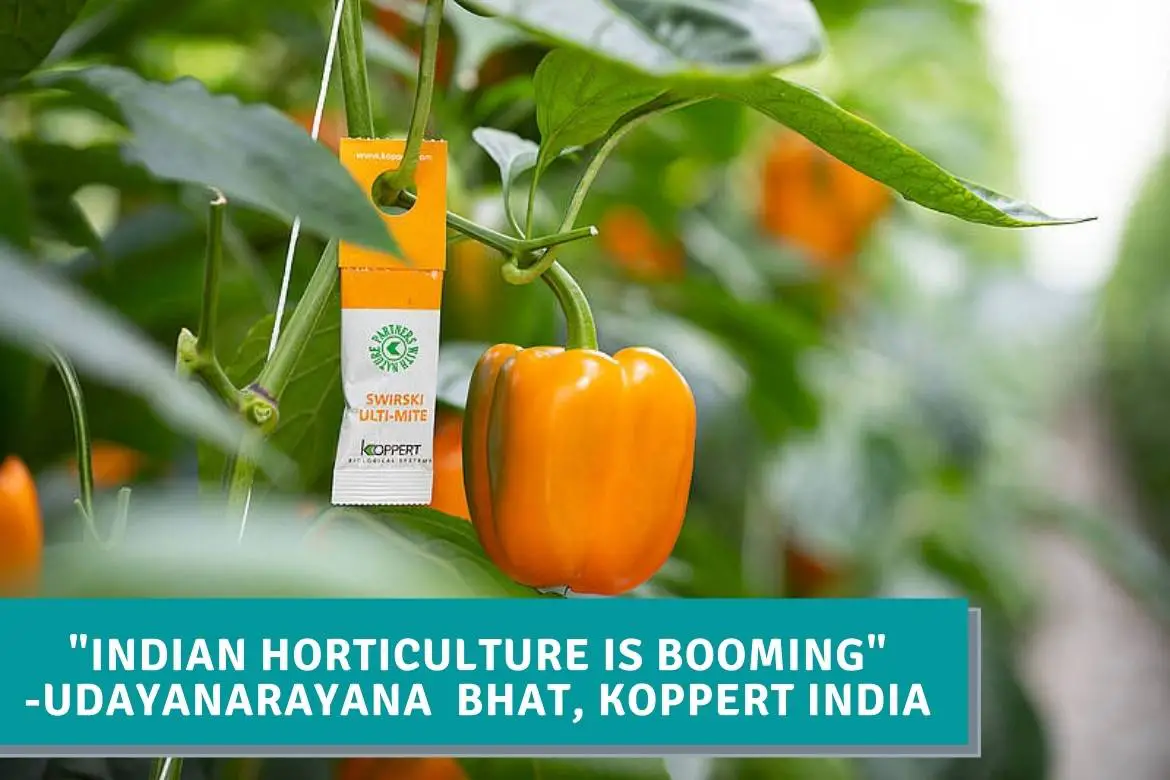The greenhouse horticulture industry in India is growing rapidly. It is still possible to double farmer income by 2022, but the government wants to increase productivity in order to do so. It remains to be overcome a number of challenges, particularly in the areas of logistics and energy, says Udayanarayana Bhat of Koppert India. Additionally, there is a great need for mid-tech technologies. Earlier this year, Koppert joined the Dutch Greenhouse Delta (DGD). To succeed in complex greenhouse horticulture projects in India, DGD collaborates between industry, government, and science.
Koppert Biological Systems develops, produces, and sells natural and biological solutions that enhance plant health and soil health. This includes natural enemies that combat insect pests, bumblebees for natural pollination, biostimulants, and microbial solutions that improve soil and plant health. Pest monitoring and trapping systems go hand in hand with this.
There are about 30 Koppert subsidiaries abroad, including one in India, and Koppert serves over 95 countries.

“Koppert has been active in India since 2012,” explains Udayanarayana Bhat, Director of Koppert India. After receiving a horticultural education, he now has almost thirty years of experience in the horticultural sector, both in India and East Africa. “We came down here because the companies that produced and exported chili to the United Kingdom could no longer control the thrips infestation with chemicals. Our natural enemies offered a solution to this.”
Koppert’s natural enemies, however, cannot be used in Indian horticulture as of 2019.
“This has to do with the Indian government’s current policy. To try and change this situation, we have been in an ongoing dialogue with the government. Our natural enemies, after all, contribute to sustainable food production. And this is a must since more and more pests are becoming resistant to chemical agents. For that reason, the Indian government also wants to expand organic food production; Koppert can make an important contribution to this. We can also help to improve food safety further and meet sustainable development goals.”
In spite of the current situation, Koppert is still active in India: mainly through the production of biostimulants, biofertilizers, and plant nutrition products. “We supply these to horticultural companies in India, but they are also exported to other countries, such as Kenya.”
Koppert, and other Dutch suppliers, are finding India to be an increasingly interesting market. In India, horticulture is on the rise.
“Traditionally, the focus in India was on growing arable crops in the open: rice, wheat, maize, potatoes, et cetera. However, this form of food production has been surpassed by horticulture production in the past two years. This includes outdoor crops such as bananas, mangoes, grapes, citrus, apples, papaya, et cetera. There is a great diversity of crops, partly because of India’s varied climatic zones.”

Horticulture in greenhouses is also growing in India. Polyhouses have grown cut flowers since the 1990s, but greenhouse vegetable production has increased recently as well.
“Think, for example, of cherry tomatoes, snack cucumbers, lettuce, peppers, sweet peppers, et cetera. The Indian greenhouse horticulture now covers some 4,000 hectares and is mainly concentrated in the south and west of the country. The greenhouses are mainly built by farmers and companies that are already active in the agricultural sector. They are usually not large; most greenhouses are only 0.4 hectares in size. The largest greenhouse farms in India are about 15 to 20 hectares.”
In the financial year 2020-2021, India will produce 326 million tons of horticultural products. According to Uday, we haven’t reached the ceiling yet.
“The demand for locally grown crops is increasing enormously. The Indian population is growing, the average income is increasing, and the middle class, in particular, is expanding. The country also has more large hotels, which want fresh, local produce. Greenhouse horticulture also offers entrepreneurs more opportunities to achieve higher production per square meter and thus higher returns. As a result, more and more traditional farmers are switching to horticulture.”
By 2022, the Indian government plans to double the country’s horticulture production. Therefore, the construction of new polyhouse is heavily subsidized.
“In addition, the government introduced the National Food Security Act in 2013. It stipulates that safe food must be made available to the entire Indian population. To achieve this, producers also receive a minimum price for their products. The government also provides support to farmers and horticulturists in growing safe food products.”
Even though there is sufficient demand and the Indian government is interested in the advancement of greenhouse agriculture, logistics remains a challenge.
“The greenhouses are scattered throughout the country. Airports are often hundreds of kilometers away, while road traffic is extremely busy. This makes it extremely difficult to get fresh produce to its destination on time.”
Furthermore, many farms do not have enough refrigeration space to store their produce.
“As a result, as much as thirty percent of the harvest is lost in some places. So, something really needs to be done in this area. Fortunately, the government is also prepared to support entrepreneurs financially.”
During certain times of the year, technology is also required to cool greenhouses in hot areas, adds Uday.
“Indian entrepreneurs are eager for mid-tech technology in this respect; for example, in the form of foggers. High-tech technologies are not an option; they are simply too expensive. In summary, Indian horticulture is booming, and there are plenty of opportunities in the mid-tech segment, also for Dutch suppliers. Collaboration within a platform such as the Dutch Greenhouse Delta can help capitalize on these opportunities.”
Source : dutchgreenhousedelta

